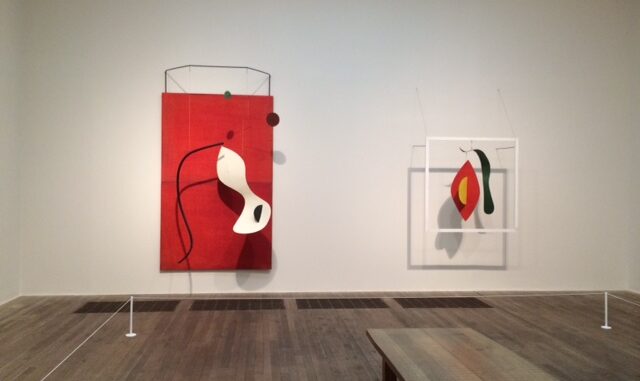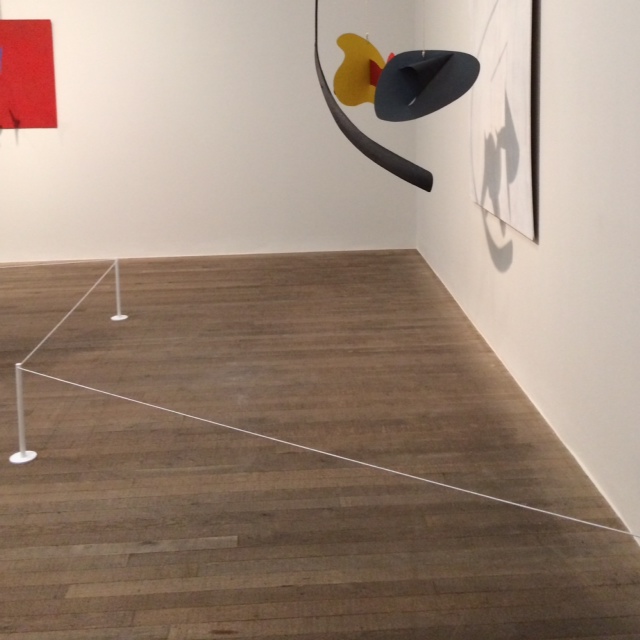
‘My fan mail is enormous—everybody is under six’ , Alexander Calder.
Signs asking you not to touch are normal in an art gallery. Signs telling you not to blow are much rarer. The admonition in Room One of Alexander Calder: Performing Sculptures at Tate Modern sums up the problem with the whole show. The artist made the sculptures to move and to be interacted with, but in this exhibition they are not allowed to perform. Given the name the exhibition has been given this is particularly disappointing.
The show concentrates on his early work up until 1948. (Born in 1898 Calder continued working until his death in 1976). His earliest works show an interest in space and unusual materials, creating caricatures and portraits out of twisted wire. Not elegant fine-art wire, but thick clod-hopping stuff that would have needed huge pliers to bend into shape. Some of these works are as clumsy as the technique suggests, a few are delicate 3D drawings, casting shadows on the walls behind them and reminding that the lighting to a Calder exhibition is key. Here the Tate has been successful.
Calder’s artworks are supposed to be playful and interactive, but too many have been rendered sterile. They may have been designed to move, but here they sit still. Some do move gently as people pass underneath; these are far more interesting and far more representative of what Calder wanted the viewer to experience. And that is another issue. The way the exhibition has been laid out we are very much viewers. I have never seen artworks fenced off so severely, the do not cross lines often two or three metres from the walls.

The placement of the barriers make very large No-Go areas
Working replicas that could be touched could easily have been created for the show and would have been far, far more appealing than the small iPad-sized screens of old video of some of the works moving. Having heard the Tate director quip to the Calder Foundation director, I know you’re watching very much the copyright, I suspect that the Calder people have insisted on the sterile art-as-terribly-important-object approach. This mocks the essence of the pieces which lack all po-facery.
This is most obvious in Room 2 where Small Sphere and Heavy Sphere is installed. Calder created this as an interactive piece. Two spheres hang down amongst bottles and gongs. Viewers participated by moving the bottles and gongs about on the floor and then pushing one sphere so that the other randomly banged into the different items and made a unique tune. (Well, tune is probably being too generous. Let’s say noise). Here the piece is merely displayed, no going near it allowed, certainly no touching. A replica would have been simplicity itself to make – give me a piece of string, some bottles and a gong and I could knock one up in a quarter of an hour. The point is to be involved, to make spontaneous music, to smile. Instead you stand and ponder the uselessness of age, the way we lose abilities until we look the same but can’t actually do anything at all.
You probably learned the importance of weight times distance from the fulcrum at school. Most of us have only ever needed to know it when messing about on see-saws, but it is the vital equation on which Calder’s mobiles rest. Or rather hang – each having only one connection to the ceiling yet balancing perfectly like bizarre constellations in galaxies far, far away. The equilibrium of the whole is dependent on all the other parts, no matter how small and seemingly insignificant. There’s a need for teamwork amongst the discs and shapes, particularly obvious in Gamma 1947 which hangs above us like a crazed government surveillance device, picking up the thoughts of art galleristas.

The merchandise available is carefully controlled. Why no mobiles?
Calder was first to create these types of mobile artworks for which he deserves much credit, bringing actual movement – that the contemporaneous Futurists were so keen on painting – into the gallery. Some of the later mobiles retain a visual elegance, but the work has dated. We are so used to mobiles that the magic is gone, whilst works that are supposed to move and do not are merely relics, impossible to admire.
A Foundation run by his family controls his legacy. No doubt they realised what a Tate Modern survey could add to Calder’s CV and his prices. The show is a slick operation but it is antiseptic and tries to cerebral-ise work that was made for more playful interaction.
PLUS: See the first entry in our new series on the new phenomenon of ArtTat.

This encapsulates what I found and I’m shocked that all the other reviews I’ve read did not touch upon the lack of movement. It could have been an amazing exhibition but instead was sterile due to the fundamental elements of movement and sound missing
I totally agree. You have so accurately spoken my thoughts it’s uncanny. The exhibition is entitled “performing” sculptures. At the very least there should have been either mock-ups or better quality films/videos demonstrating the actions of the mobiles. Also, reference towards the end of the exhibition towards Calder’s collaboration with musicians and yet…..no sound track, no real sense of the fun, frivolity and sheer joy that Calder clearly had in his own work. The powers that be obviously feel that by elevating the work to a status whereby they could never possibly be mistaken for ‘fun’ they are safeguarding the works right to be ‘Art’. A mistaken attitude in my opinion.
Thanks for your comments Caroline. The fun did seem to have been drained out.